Economics for Business Students: Tobacco, Youth Unemployment Analysis
VerifiedAdded on 2023/06/05
|16
|3433
|106
Essay
AI Summary
This essay provides an economic analysis of tobacco control measures, specifically focusing on the impact of excise duties on cigarette consumption in Australia and Pakistan. It examines the effectiveness of government interventions, including taxation, advertising restrictions, and plain packaging, in reducing smoking rates and related healthcare costs. The essay further investigates the issue of youth unemployment in both countries, exploring structural and cyclical unemployment factors, labor market dynamics, and the challenges faced by young people in securing employment. It highlights the differences in smoking rates and unemployment levels between the two countries, as well as the similarities in their approaches to addressing these issues, providing a comparative perspective on the economic and social implications of these challenges. The analysis includes discussions of cost-benefit analysis, interventionist mechanisms, and the role of government policies in shaping economic outcomes related to tobacco use and youth employment.
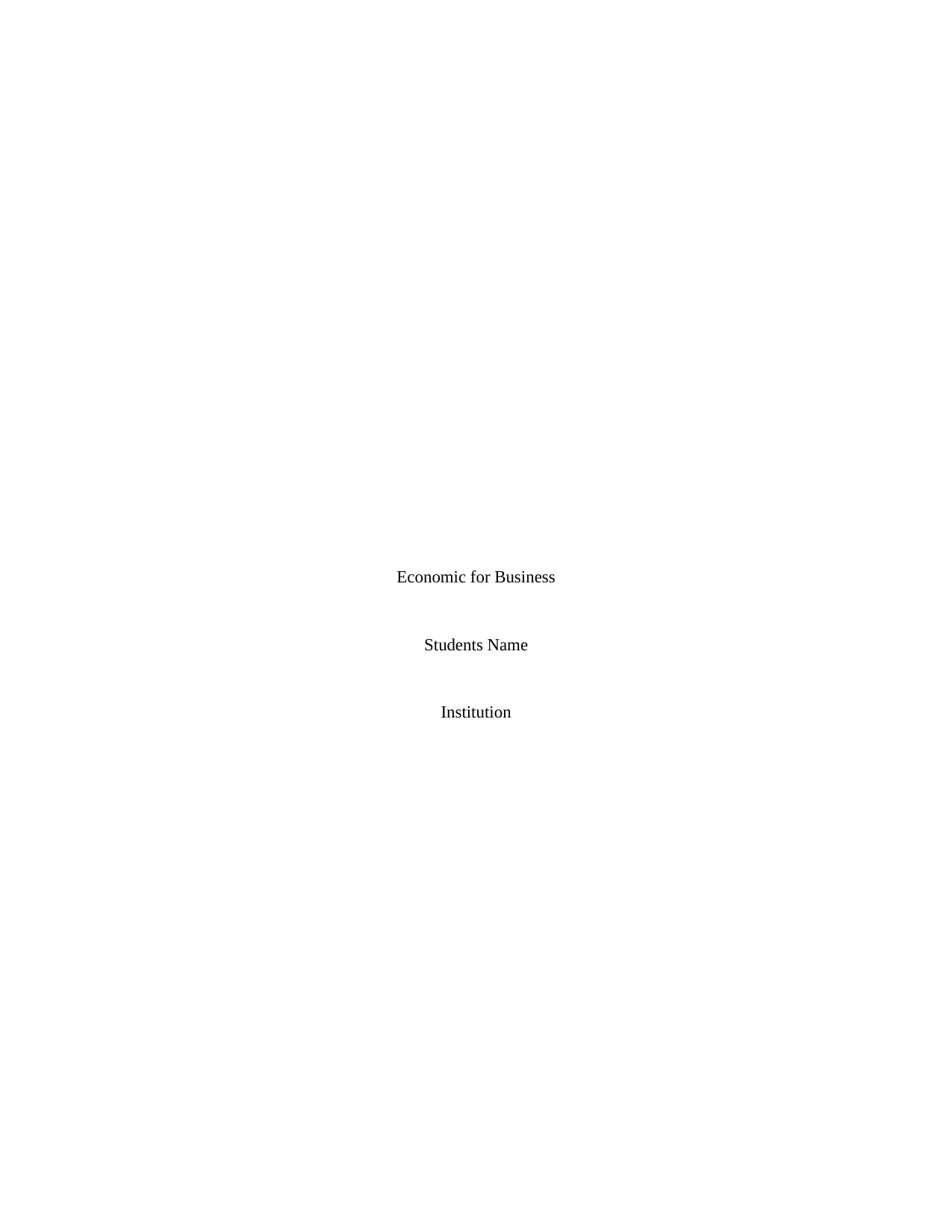
Economic for Business
Students Name
Institution
Students Name
Institution
Paraphrase This Document
Need a fresh take? Get an instant paraphrase of this document with our AI Paraphraser
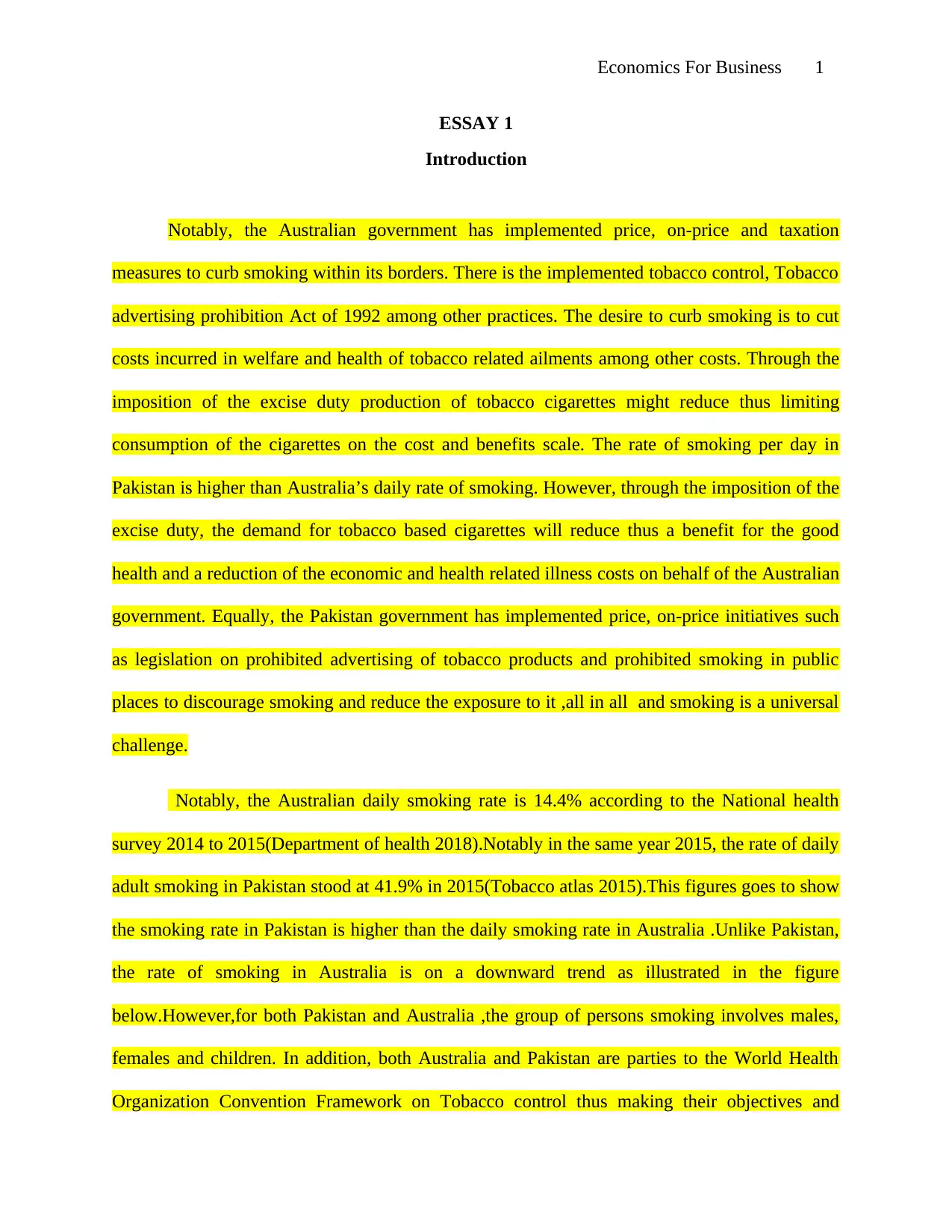
Economics For Business 1
ESSAY 1
Introduction
Notably, the Australian government has implemented price, on-price and taxation
measures to curb smoking within its borders. There is the implemented tobacco control, Tobacco
advertising prohibition Act of 1992 among other practices. The desire to curb smoking is to cut
costs incurred in welfare and health of tobacco related ailments among other costs. Through the
imposition of the excise duty production of tobacco cigarettes might reduce thus limiting
consumption of the cigarettes on the cost and benefits scale. The rate of smoking per day in
Pakistan is higher than Australia’s daily rate of smoking. However, through the imposition of the
excise duty, the demand for tobacco based cigarettes will reduce thus a benefit for the good
health and a reduction of the economic and health related illness costs on behalf of the Australian
government. Equally, the Pakistan government has implemented price, on-price initiatives such
as legislation on prohibited advertising of tobacco products and prohibited smoking in public
places to discourage smoking and reduce the exposure to it ,all in all and smoking is a universal
challenge.
Notably, the Australian daily smoking rate is 14.4% according to the National health
survey 2014 to 2015(Department of health 2018).Notably in the same year 2015, the rate of daily
adult smoking in Pakistan stood at 41.9% in 2015(Tobacco atlas 2015).This figures goes to show
the smoking rate in Pakistan is higher than the daily smoking rate in Australia .Unlike Pakistan,
the rate of smoking in Australia is on a downward trend as illustrated in the figure
below.However,for both Pakistan and Australia ,the group of persons smoking involves males,
females and children. In addition, both Australia and Pakistan are parties to the World Health
Organization Convention Framework on Tobacco control thus making their objectives and
ESSAY 1
Introduction
Notably, the Australian government has implemented price, on-price and taxation
measures to curb smoking within its borders. There is the implemented tobacco control, Tobacco
advertising prohibition Act of 1992 among other practices. The desire to curb smoking is to cut
costs incurred in welfare and health of tobacco related ailments among other costs. Through the
imposition of the excise duty production of tobacco cigarettes might reduce thus limiting
consumption of the cigarettes on the cost and benefits scale. The rate of smoking per day in
Pakistan is higher than Australia’s daily rate of smoking. However, through the imposition of the
excise duty, the demand for tobacco based cigarettes will reduce thus a benefit for the good
health and a reduction of the economic and health related illness costs on behalf of the Australian
government. Equally, the Pakistan government has implemented price, on-price initiatives such
as legislation on prohibited advertising of tobacco products and prohibited smoking in public
places to discourage smoking and reduce the exposure to it ,all in all and smoking is a universal
challenge.
Notably, the Australian daily smoking rate is 14.4% according to the National health
survey 2014 to 2015(Department of health 2018).Notably in the same year 2015, the rate of daily
adult smoking in Pakistan stood at 41.9% in 2015(Tobacco atlas 2015).This figures goes to show
the smoking rate in Pakistan is higher than the daily smoking rate in Australia .Unlike Pakistan,
the rate of smoking in Australia is on a downward trend as illustrated in the figure
below.However,for both Pakistan and Australia ,the group of persons smoking involves males,
females and children. In addition, both Australia and Pakistan are parties to the World Health
Organization Convention Framework on Tobacco control thus making their objectives and
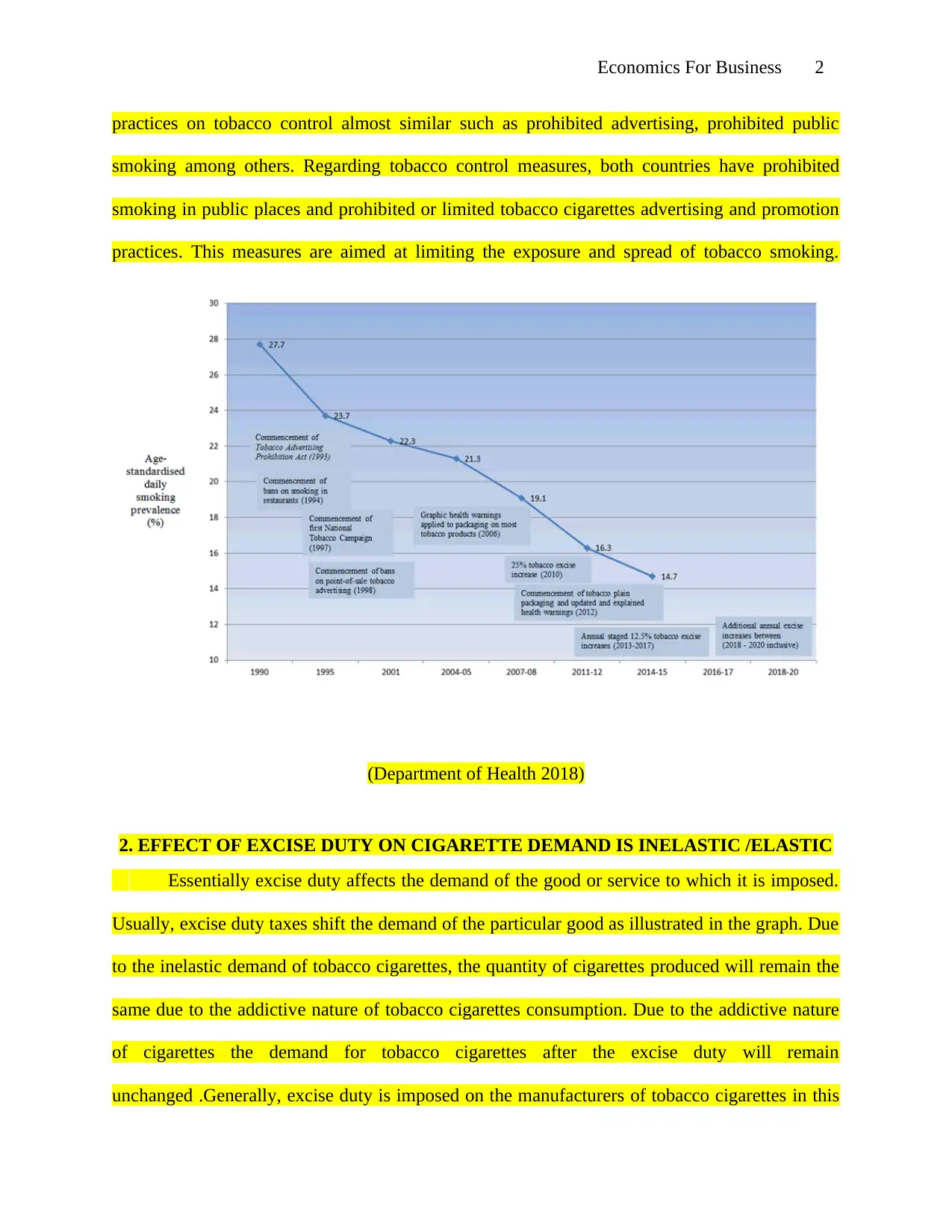
Economics For Business 2
practices on tobacco control almost similar such as prohibited advertising, prohibited public
smoking among others. Regarding tobacco control measures, both countries have prohibited
smoking in public places and prohibited or limited tobacco cigarettes advertising and promotion
practices. This measures are aimed at limiting the exposure and spread of tobacco smoking.
(Department of Health 2018)
2. EFFECT OF EXCISE DUTY ON CIGARETTE DEMAND IS INELASTIC /ELASTIC
Essentially excise duty affects the demand of the good or service to which it is imposed.
Usually, excise duty taxes shift the demand of the particular good as illustrated in the graph. Due
to the inelastic demand of tobacco cigarettes, the quantity of cigarettes produced will remain the
same due to the addictive nature of tobacco cigarettes consumption. Due to the addictive nature
of cigarettes the demand for tobacco cigarettes after the excise duty will remain
unchanged .Generally, excise duty is imposed on the manufacturers of tobacco cigarettes in this
practices on tobacco control almost similar such as prohibited advertising, prohibited public
smoking among others. Regarding tobacco control measures, both countries have prohibited
smoking in public places and prohibited or limited tobacco cigarettes advertising and promotion
practices. This measures are aimed at limiting the exposure and spread of tobacco smoking.
(Department of Health 2018)
2. EFFECT OF EXCISE DUTY ON CIGARETTE DEMAND IS INELASTIC /ELASTIC
Essentially excise duty affects the demand of the good or service to which it is imposed.
Usually, excise duty taxes shift the demand of the particular good as illustrated in the graph. Due
to the inelastic demand of tobacco cigarettes, the quantity of cigarettes produced will remain the
same due to the addictive nature of tobacco cigarettes consumption. Due to the addictive nature
of cigarettes the demand for tobacco cigarettes after the excise duty will remain
unchanged .Generally, excise duty is imposed on the manufacturers of tobacco cigarettes in this
⊘ This is a preview!⊘
Do you want full access?
Subscribe today to unlock all pages.

Trusted by 1+ million students worldwide
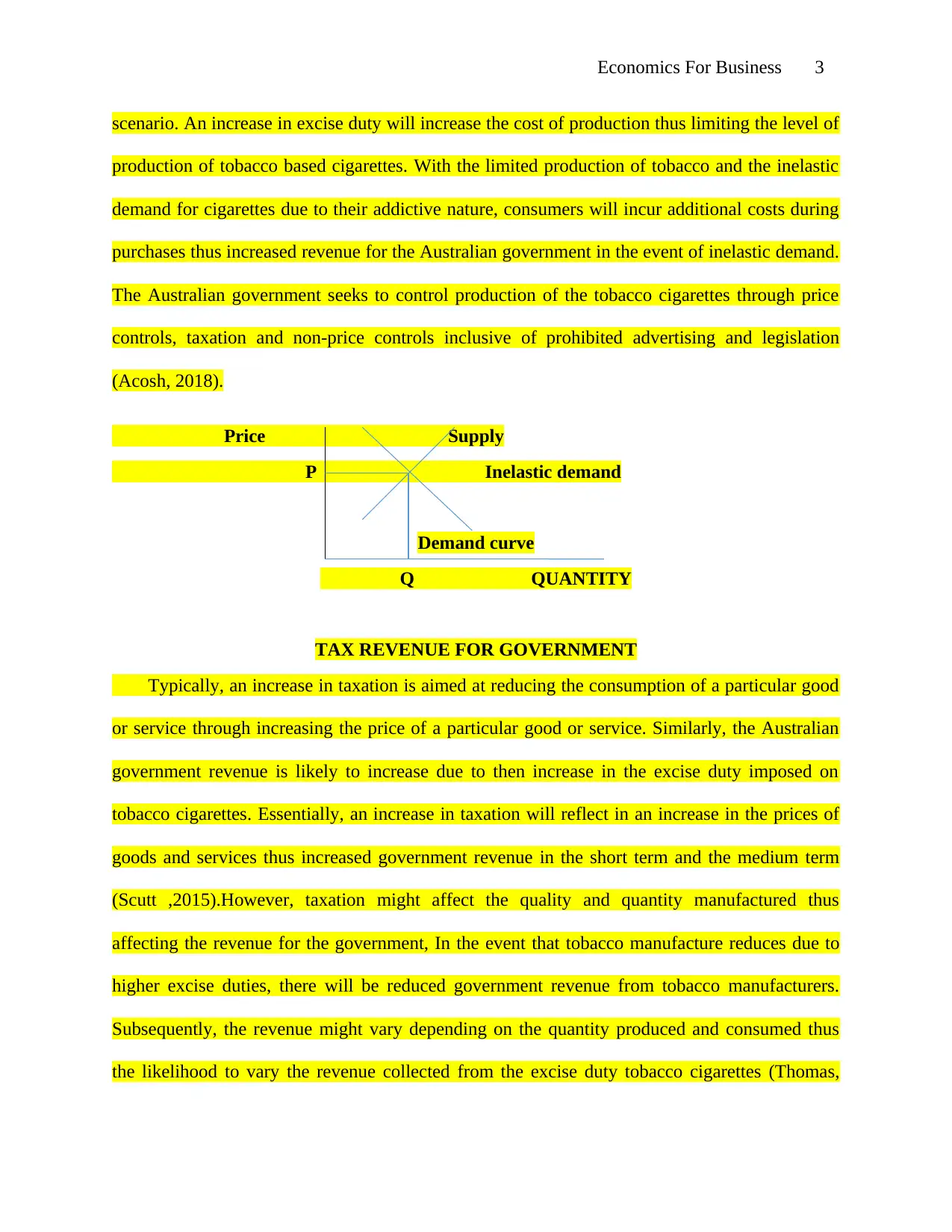
Economics For Business 3
scenario. An increase in excise duty will increase the cost of production thus limiting the level of
production of tobacco based cigarettes. With the limited production of tobacco and the inelastic
demand for cigarettes due to their addictive nature, consumers will incur additional costs during
purchases thus increased revenue for the Australian government in the event of inelastic demand.
The Australian government seeks to control production of the tobacco cigarettes through price
controls, taxation and non-price controls inclusive of prohibited advertising and legislation
(Acosh, 2018).
Price Supply
P Inelastic demand
Demand curve
Q QUANTITY
TAX REVENUE FOR GOVERNMENT
Typically, an increase in taxation is aimed at reducing the consumption of a particular good
or service through increasing the price of a particular good or service. Similarly, the Australian
government revenue is likely to increase due to then increase in the excise duty imposed on
tobacco cigarettes. Essentially, an increase in taxation will reflect in an increase in the prices of
goods and services thus increased government revenue in the short term and the medium term
(Scutt ,2015).However, taxation might affect the quality and quantity manufactured thus
affecting the revenue for the government, In the event that tobacco manufacture reduces due to
higher excise duties, there will be reduced government revenue from tobacco manufacturers.
Subsequently, the revenue might vary depending on the quantity produced and consumed thus
the likelihood to vary the revenue collected from the excise duty tobacco cigarettes (Thomas,
scenario. An increase in excise duty will increase the cost of production thus limiting the level of
production of tobacco based cigarettes. With the limited production of tobacco and the inelastic
demand for cigarettes due to their addictive nature, consumers will incur additional costs during
purchases thus increased revenue for the Australian government in the event of inelastic demand.
The Australian government seeks to control production of the tobacco cigarettes through price
controls, taxation and non-price controls inclusive of prohibited advertising and legislation
(Acosh, 2018).
Price Supply
P Inelastic demand
Demand curve
Q QUANTITY
TAX REVENUE FOR GOVERNMENT
Typically, an increase in taxation is aimed at reducing the consumption of a particular good
or service through increasing the price of a particular good or service. Similarly, the Australian
government revenue is likely to increase due to then increase in the excise duty imposed on
tobacco cigarettes. Essentially, an increase in taxation will reflect in an increase in the prices of
goods and services thus increased government revenue in the short term and the medium term
(Scutt ,2015).However, taxation might affect the quality and quantity manufactured thus
affecting the revenue for the government, In the event that tobacco manufacture reduces due to
higher excise duties, there will be reduced government revenue from tobacco manufacturers.
Subsequently, the revenue might vary depending on the quantity produced and consumed thus
the likelihood to vary the revenue collected from the excise duty tobacco cigarettes (Thomas,
Paraphrase This Document
Need a fresh take? Get an instant paraphrase of this document with our AI Paraphraser
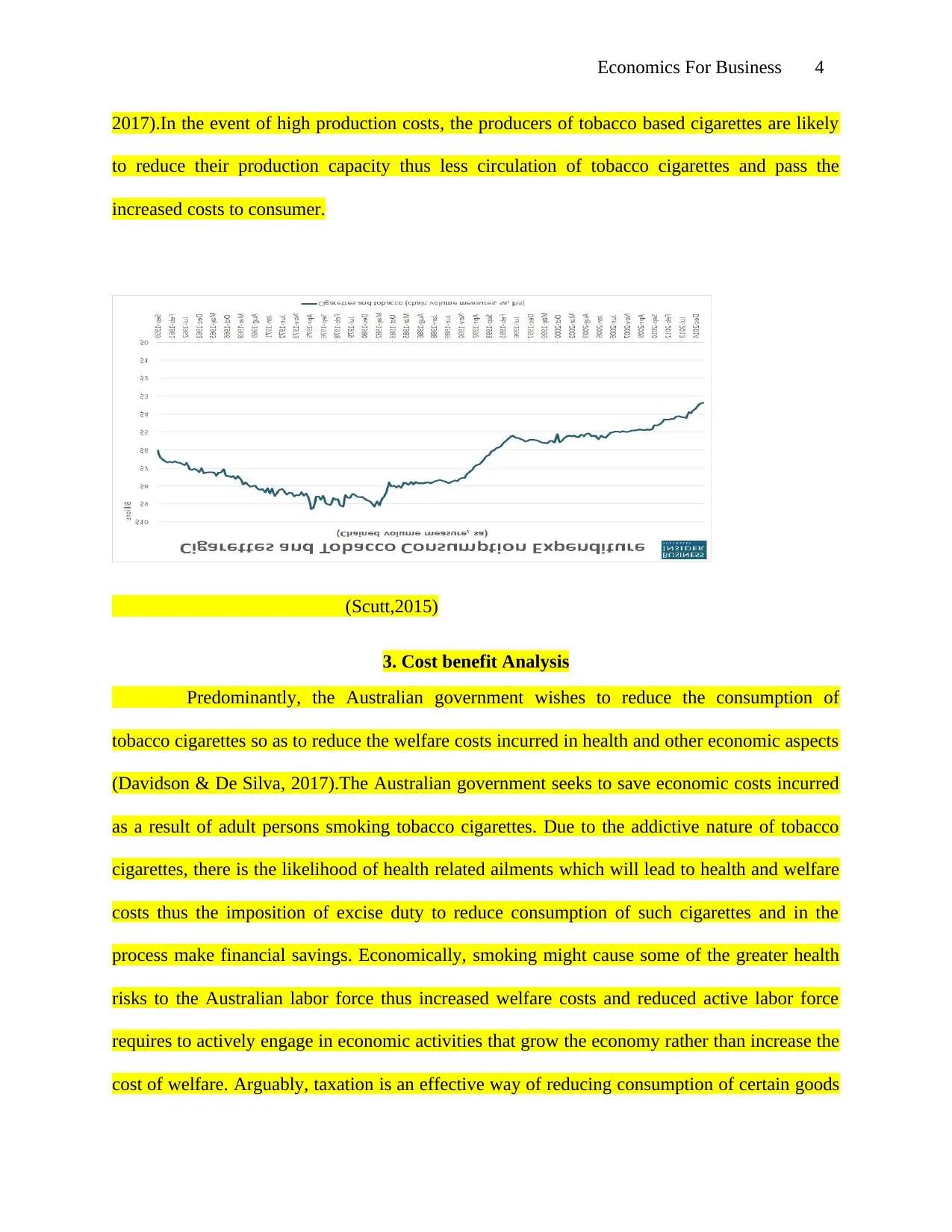
Economics For Business 4
2017).In the event of high production costs, the producers of tobacco based cigarettes are likely
to reduce their production capacity thus less circulation of tobacco cigarettes and pass the
increased costs to consumer.
(Scutt,2015)
3. Cost benefit Analysis
Predominantly, the Australian government wishes to reduce the consumption of
tobacco cigarettes so as to reduce the welfare costs incurred in health and other economic aspects
(Davidson & De Silva, 2017).The Australian government seeks to save economic costs incurred
as a result of adult persons smoking tobacco cigarettes. Due to the addictive nature of tobacco
cigarettes, there is the likelihood of health related ailments which will lead to health and welfare
costs thus the imposition of excise duty to reduce consumption of such cigarettes and in the
process make financial savings. Economically, smoking might cause some of the greater health
risks to the Australian labor force thus increased welfare costs and reduced active labor force
requires to actively engage in economic activities that grow the economy rather than increase the
cost of welfare. Arguably, taxation is an effective way of reducing consumption of certain goods
2017).In the event of high production costs, the producers of tobacco based cigarettes are likely
to reduce their production capacity thus less circulation of tobacco cigarettes and pass the
increased costs to consumer.
(Scutt,2015)
3. Cost benefit Analysis
Predominantly, the Australian government wishes to reduce the consumption of
tobacco cigarettes so as to reduce the welfare costs incurred in health and other economic aspects
(Davidson & De Silva, 2017).The Australian government seeks to save economic costs incurred
as a result of adult persons smoking tobacco cigarettes. Due to the addictive nature of tobacco
cigarettes, there is the likelihood of health related ailments which will lead to health and welfare
costs thus the imposition of excise duty to reduce consumption of such cigarettes and in the
process make financial savings. Economically, smoking might cause some of the greater health
risks to the Australian labor force thus increased welfare costs and reduced active labor force
requires to actively engage in economic activities that grow the economy rather than increase the
cost of welfare. Arguably, taxation is an effective way of reducing consumption of certain goods
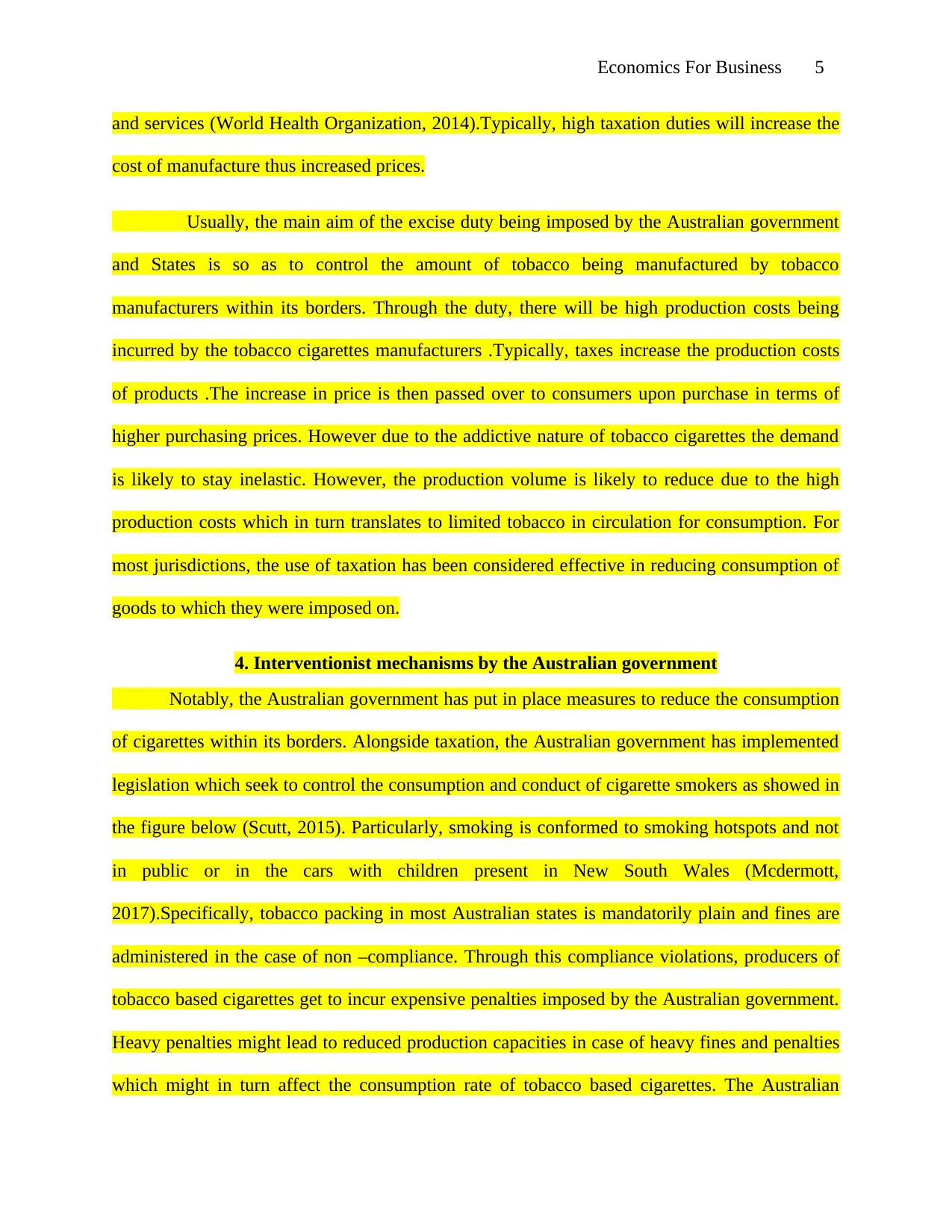
Economics For Business 5
and services (World Health Organization, 2014).Typically, high taxation duties will increase the
cost of manufacture thus increased prices.
Usually, the main aim of the excise duty being imposed by the Australian government
and States is so as to control the amount of tobacco being manufactured by tobacco
manufacturers within its borders. Through the duty, there will be high production costs being
incurred by the tobacco cigarettes manufacturers .Typically, taxes increase the production costs
of products .The increase in price is then passed over to consumers upon purchase in terms of
higher purchasing prices. However due to the addictive nature of tobacco cigarettes the demand
is likely to stay inelastic. However, the production volume is likely to reduce due to the high
production costs which in turn translates to limited tobacco in circulation for consumption. For
most jurisdictions, the use of taxation has been considered effective in reducing consumption of
goods to which they were imposed on.
4. Interventionist mechanisms by the Australian government
Notably, the Australian government has put in place measures to reduce the consumption
of cigarettes within its borders. Alongside taxation, the Australian government has implemented
legislation which seek to control the consumption and conduct of cigarette smokers as showed in
the figure below (Scutt, 2015). Particularly, smoking is conformed to smoking hotspots and not
in public or in the cars with children present in New South Wales (Mcdermott,
2017).Specifically, tobacco packing in most Australian states is mandatorily plain and fines are
administered in the case of non –compliance. Through this compliance violations, producers of
tobacco based cigarettes get to incur expensive penalties imposed by the Australian government.
Heavy penalties might lead to reduced production capacities in case of heavy fines and penalties
which might in turn affect the consumption rate of tobacco based cigarettes. The Australian
and services (World Health Organization, 2014).Typically, high taxation duties will increase the
cost of manufacture thus increased prices.
Usually, the main aim of the excise duty being imposed by the Australian government
and States is so as to control the amount of tobacco being manufactured by tobacco
manufacturers within its borders. Through the duty, there will be high production costs being
incurred by the tobacco cigarettes manufacturers .Typically, taxes increase the production costs
of products .The increase in price is then passed over to consumers upon purchase in terms of
higher purchasing prices. However due to the addictive nature of tobacco cigarettes the demand
is likely to stay inelastic. However, the production volume is likely to reduce due to the high
production costs which in turn translates to limited tobacco in circulation for consumption. For
most jurisdictions, the use of taxation has been considered effective in reducing consumption of
goods to which they were imposed on.
4. Interventionist mechanisms by the Australian government
Notably, the Australian government has put in place measures to reduce the consumption
of cigarettes within its borders. Alongside taxation, the Australian government has implemented
legislation which seek to control the consumption and conduct of cigarette smokers as showed in
the figure below (Scutt, 2015). Particularly, smoking is conformed to smoking hotspots and not
in public or in the cars with children present in New South Wales (Mcdermott,
2017).Specifically, tobacco packing in most Australian states is mandatorily plain and fines are
administered in the case of non –compliance. Through this compliance violations, producers of
tobacco based cigarettes get to incur expensive penalties imposed by the Australian government.
Heavy penalties might lead to reduced production capacities in case of heavy fines and penalties
which might in turn affect the consumption rate of tobacco based cigarettes. The Australian
⊘ This is a preview!⊘
Do you want full access?
Subscribe today to unlock all pages.

Trusted by 1+ million students worldwide
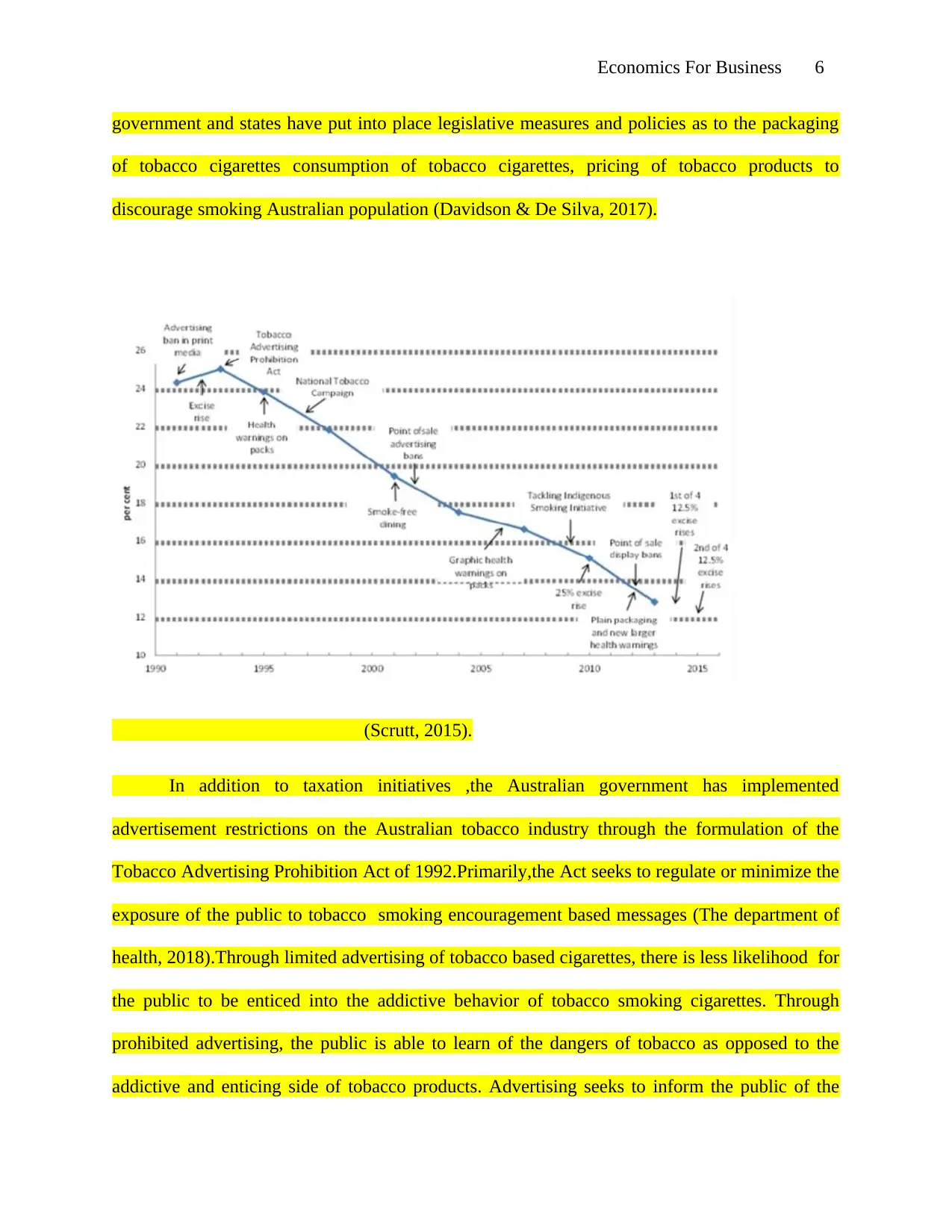
Economics For Business 6
government and states have put into place legislative measures and policies as to the packaging
of tobacco cigarettes consumption of tobacco cigarettes, pricing of tobacco products to
discourage smoking Australian population (Davidson & De Silva, 2017).
(Scrutt, 2015).
In addition to taxation initiatives ,the Australian government has implemented
advertisement restrictions on the Australian tobacco industry through the formulation of the
Tobacco Advertising Prohibition Act of 1992.Primarily,the Act seeks to regulate or minimize the
exposure of the public to tobacco smoking encouragement based messages (The department of
health, 2018).Through limited advertising of tobacco based cigarettes, there is less likelihood for
the public to be enticed into the addictive behavior of tobacco smoking cigarettes. Through
prohibited advertising, the public is able to learn of the dangers of tobacco as opposed to the
addictive and enticing side of tobacco products. Advertising seeks to inform the public of the
government and states have put into place legislative measures and policies as to the packaging
of tobacco cigarettes consumption of tobacco cigarettes, pricing of tobacco products to
discourage smoking Australian population (Davidson & De Silva, 2017).
(Scrutt, 2015).
In addition to taxation initiatives ,the Australian government has implemented
advertisement restrictions on the Australian tobacco industry through the formulation of the
Tobacco Advertising Prohibition Act of 1992.Primarily,the Act seeks to regulate or minimize the
exposure of the public to tobacco smoking encouragement based messages (The department of
health, 2018).Through limited advertising of tobacco based cigarettes, there is less likelihood for
the public to be enticed into the addictive behavior of tobacco smoking cigarettes. Through
prohibited advertising, the public is able to learn of the dangers of tobacco as opposed to the
addictive and enticing side of tobacco products. Advertising seeks to inform the public of the
Paraphrase This Document
Need a fresh take? Get an instant paraphrase of this document with our AI Paraphraser
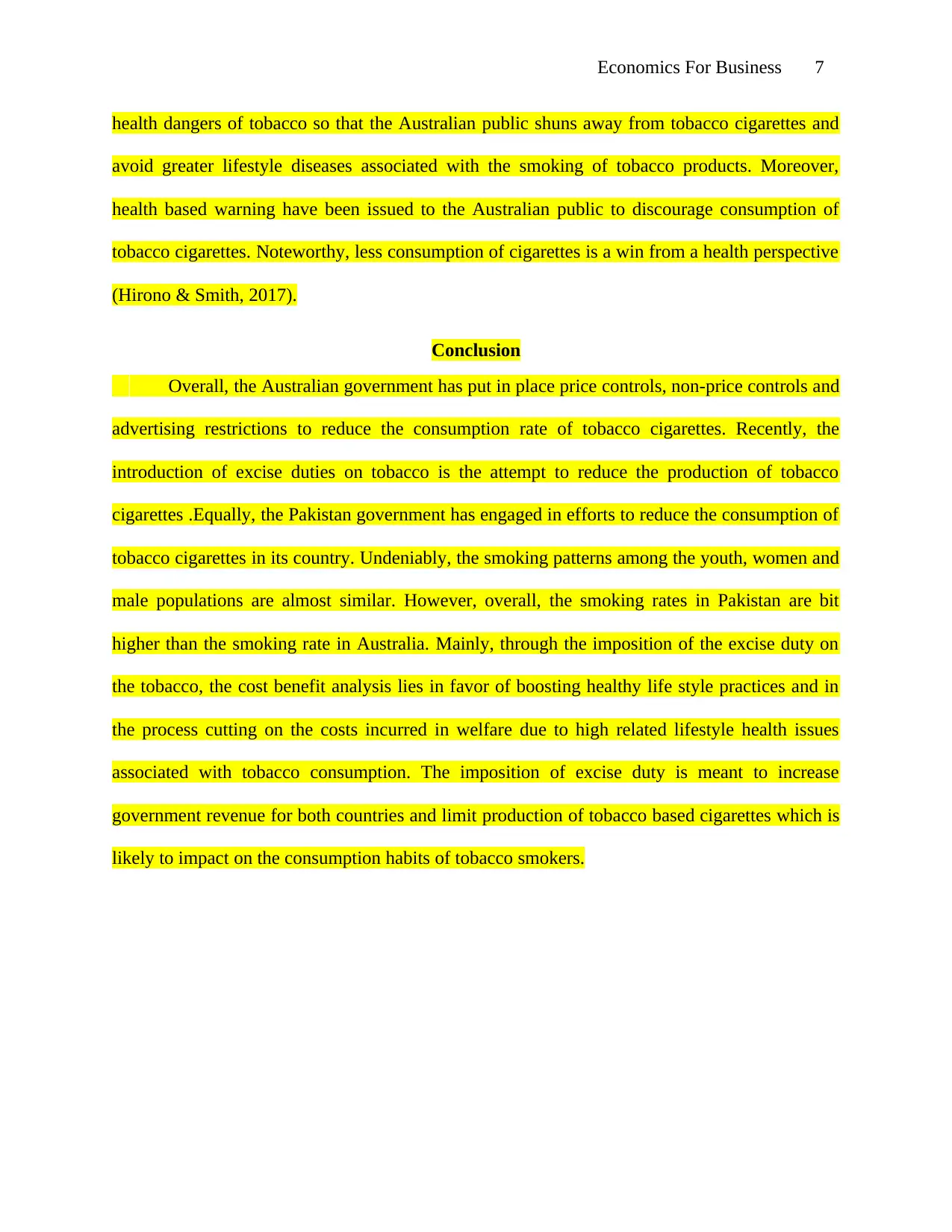
Economics For Business 7
health dangers of tobacco so that the Australian public shuns away from tobacco cigarettes and
avoid greater lifestyle diseases associated with the smoking of tobacco products. Moreover,
health based warning have been issued to the Australian public to discourage consumption of
tobacco cigarettes. Noteworthy, less consumption of cigarettes is a win from a health perspective
(Hirono & Smith, 2017).
Conclusion
Overall, the Australian government has put in place price controls, non-price controls and
advertising restrictions to reduce the consumption rate of tobacco cigarettes. Recently, the
introduction of excise duties on tobacco is the attempt to reduce the production of tobacco
cigarettes .Equally, the Pakistan government has engaged in efforts to reduce the consumption of
tobacco cigarettes in its country. Undeniably, the smoking patterns among the youth, women and
male populations are almost similar. However, overall, the smoking rates in Pakistan are bit
higher than the smoking rate in Australia. Mainly, through the imposition of the excise duty on
the tobacco, the cost benefit analysis lies in favor of boosting healthy life style practices and in
the process cutting on the costs incurred in welfare due to high related lifestyle health issues
associated with tobacco consumption. The imposition of excise duty is meant to increase
government revenue for both countries and limit production of tobacco based cigarettes which is
likely to impact on the consumption habits of tobacco smokers.
health dangers of tobacco so that the Australian public shuns away from tobacco cigarettes and
avoid greater lifestyle diseases associated with the smoking of tobacco products. Moreover,
health based warning have been issued to the Australian public to discourage consumption of
tobacco cigarettes. Noteworthy, less consumption of cigarettes is a win from a health perspective
(Hirono & Smith, 2017).
Conclusion
Overall, the Australian government has put in place price controls, non-price controls and
advertising restrictions to reduce the consumption rate of tobacco cigarettes. Recently, the
introduction of excise duties on tobacco is the attempt to reduce the production of tobacco
cigarettes .Equally, the Pakistan government has engaged in efforts to reduce the consumption of
tobacco cigarettes in its country. Undeniably, the smoking patterns among the youth, women and
male populations are almost similar. However, overall, the smoking rates in Pakistan are bit
higher than the smoking rate in Australia. Mainly, through the imposition of the excise duty on
the tobacco, the cost benefit analysis lies in favor of boosting healthy life style practices and in
the process cutting on the costs incurred in welfare due to high related lifestyle health issues
associated with tobacco consumption. The imposition of excise duty is meant to increase
government revenue for both countries and limit production of tobacco based cigarettes which is
likely to impact on the consumption habits of tobacco smokers.
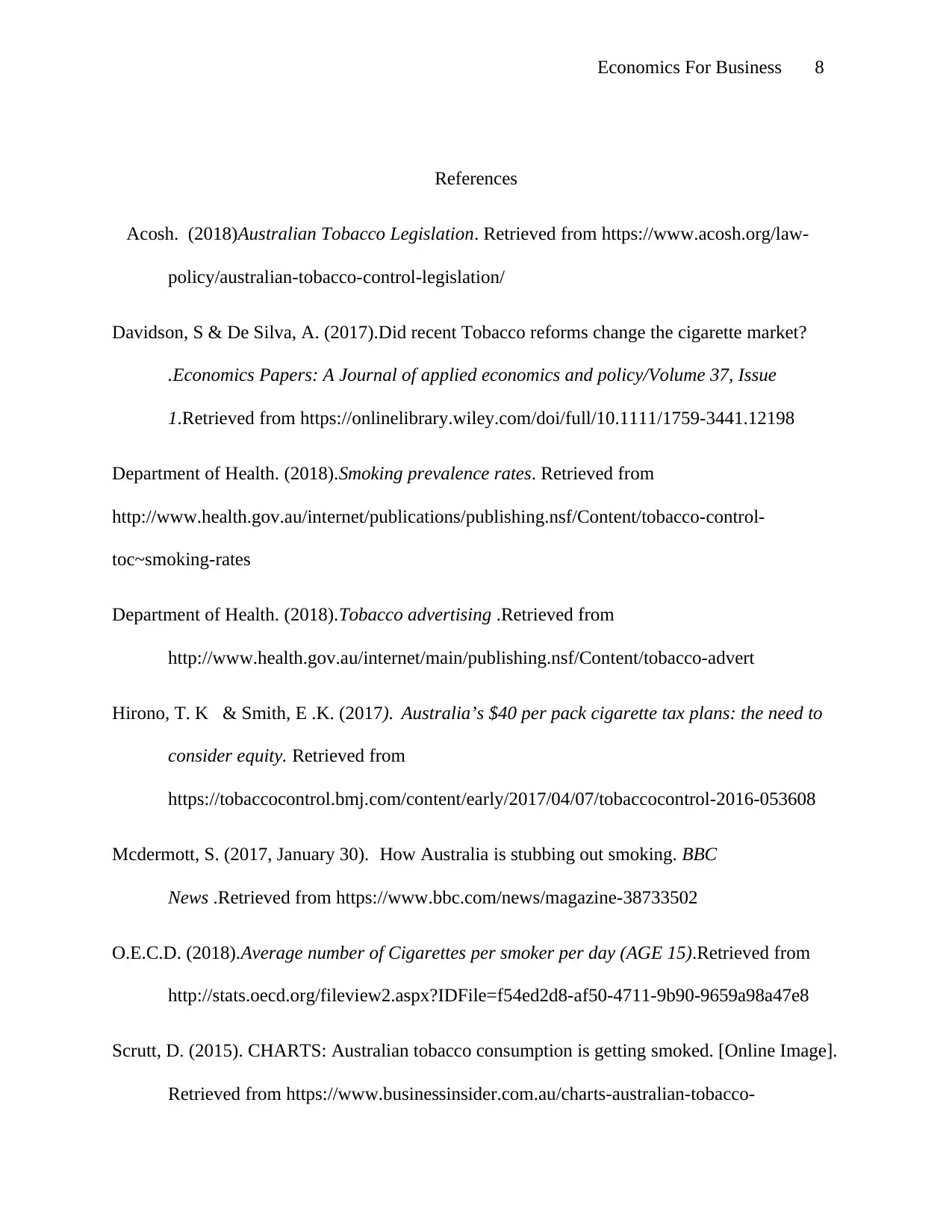
Economics For Business 8
References
Acosh. (2018)Australian Tobacco Legislation. Retrieved from https://www.acosh.org/law-
policy/australian-tobacco-control-legislation/
Davidson, S & De Silva, A. (2017).Did recent Tobacco reforms change the cigarette market?
.Economics Papers: A Journal of applied economics and policy/Volume 37, Issue
1.Retrieved from https://onlinelibrary.wiley.com/doi/full/10.1111/1759-3441.12198
Department of Health. (2018).Smoking prevalence rates. Retrieved from
http://www.health.gov.au/internet/publications/publishing.nsf/Content/tobacco-control-
toc~smoking-rates
Department of Health. (2018).Tobacco advertising .Retrieved from
http://www.health.gov.au/internet/main/publishing.nsf/Content/tobacco-advert
Hirono, T. K & Smith, E .K. (2017). Australia’s $40 per pack cigarette tax plans: the need to
consider equity. Retrieved from
https://tobaccocontrol.bmj.com/content/early/2017/04/07/tobaccocontrol-2016-053608
Mcdermott, S. (2017, January 30). How Australia is stubbing out smoking. BBC
News .Retrieved from https://www.bbc.com/news/magazine-38733502
O.E.C.D. (2018).Average number of Cigarettes per smoker per day (AGE 15).Retrieved from
http://stats.oecd.org/fileview2.aspx?IDFile=f54ed2d8-af50-4711-9b90-9659a98a47e8
Scrutt, D. (2015). CHARTS: Australian tobacco consumption is getting smoked. [Online Image].
Retrieved from https://www.businessinsider.com.au/charts-australian-tobacco-
References
Acosh. (2018)Australian Tobacco Legislation. Retrieved from https://www.acosh.org/law-
policy/australian-tobacco-control-legislation/
Davidson, S & De Silva, A. (2017).Did recent Tobacco reforms change the cigarette market?
.Economics Papers: A Journal of applied economics and policy/Volume 37, Issue
1.Retrieved from https://onlinelibrary.wiley.com/doi/full/10.1111/1759-3441.12198
Department of Health. (2018).Smoking prevalence rates. Retrieved from
http://www.health.gov.au/internet/publications/publishing.nsf/Content/tobacco-control-
toc~smoking-rates
Department of Health. (2018).Tobacco advertising .Retrieved from
http://www.health.gov.au/internet/main/publishing.nsf/Content/tobacco-advert
Hirono, T. K & Smith, E .K. (2017). Australia’s $40 per pack cigarette tax plans: the need to
consider equity. Retrieved from
https://tobaccocontrol.bmj.com/content/early/2017/04/07/tobaccocontrol-2016-053608
Mcdermott, S. (2017, January 30). How Australia is stubbing out smoking. BBC
News .Retrieved from https://www.bbc.com/news/magazine-38733502
O.E.C.D. (2018).Average number of Cigarettes per smoker per day (AGE 15).Retrieved from
http://stats.oecd.org/fileview2.aspx?IDFile=f54ed2d8-af50-4711-9b90-9659a98a47e8
Scrutt, D. (2015). CHARTS: Australian tobacco consumption is getting smoked. [Online Image].
Retrieved from https://www.businessinsider.com.au/charts-australian-tobacco-
⊘ This is a preview!⊘
Do you want full access?
Subscribe today to unlock all pages.

Trusted by 1+ million students worldwide
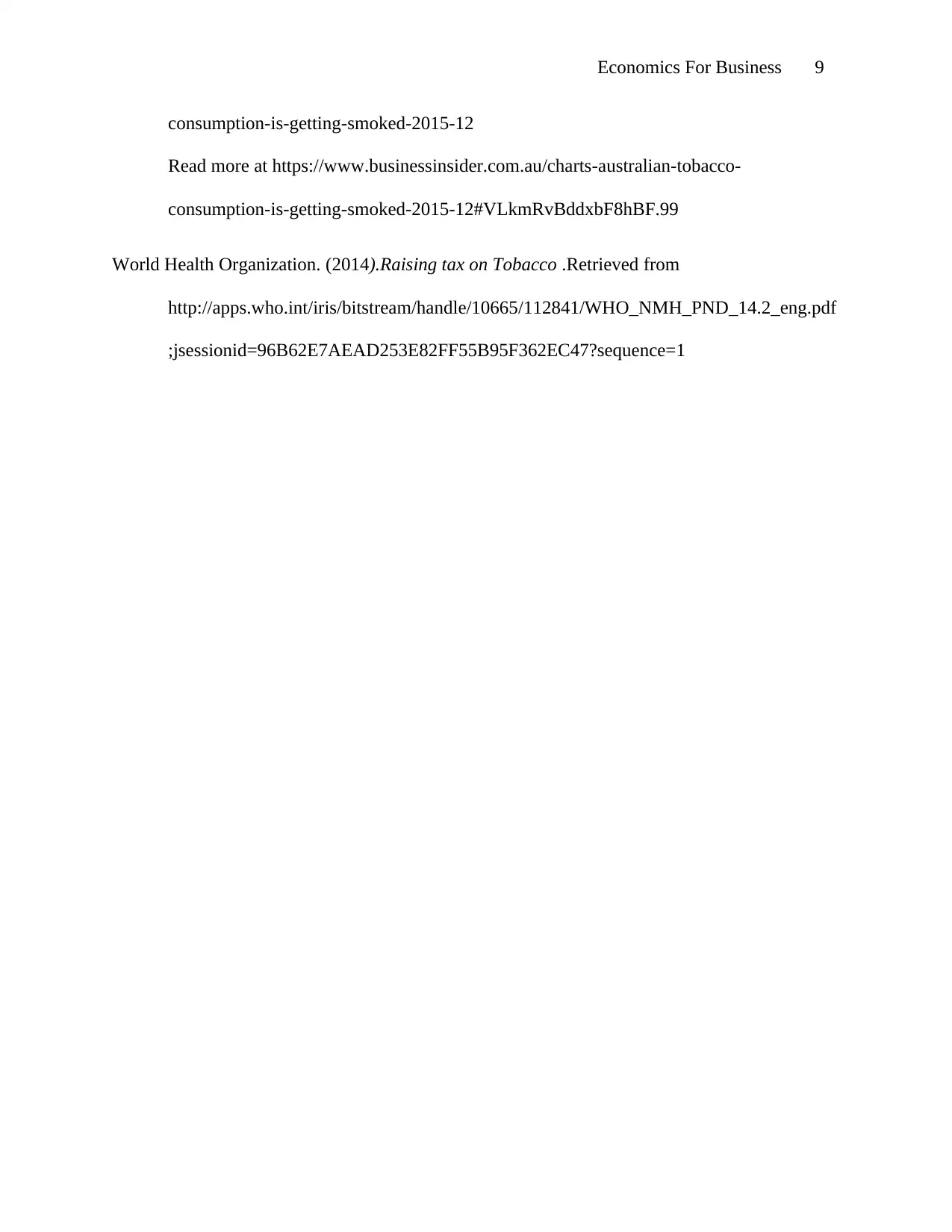
Economics For Business 9
consumption-is-getting-smoked-2015-12
Read more at https://www.businessinsider.com.au/charts-australian-tobacco-
consumption-is-getting-smoked-2015-12#VLkmRvBddxbF8hBF.99
World Health Organization. (2014).Raising tax on Tobacco .Retrieved from
http://apps.who.int/iris/bitstream/handle/10665/112841/WHO_NMH_PND_14.2_eng.pdf
;jsessionid=96B62E7AEAD253E82FF55B95F362EC47?sequence=1
consumption-is-getting-smoked-2015-12
Read more at https://www.businessinsider.com.au/charts-australian-tobacco-
consumption-is-getting-smoked-2015-12#VLkmRvBddxbF8hBF.99
World Health Organization. (2014).Raising tax on Tobacco .Retrieved from
http://apps.who.int/iris/bitstream/handle/10665/112841/WHO_NMH_PND_14.2_eng.pdf
;jsessionid=96B62E7AEAD253E82FF55B95F362EC47?sequence=1
Paraphrase This Document
Need a fresh take? Get an instant paraphrase of this document with our AI Paraphraser
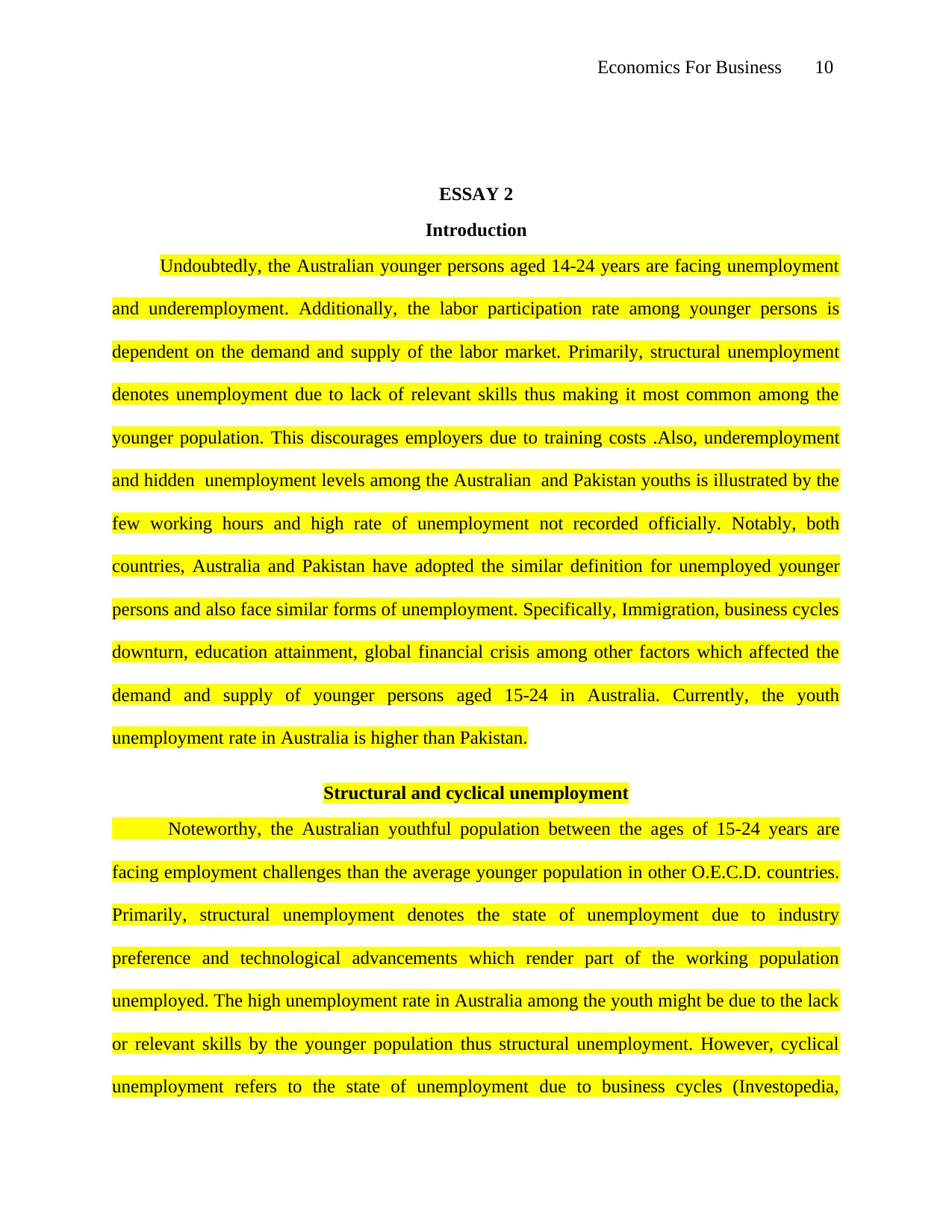
Economics For Business 10
ESSAY 2
Introduction
Undoubtedly, the Australian younger persons aged 14-24 years are facing unemployment
and underemployment. Additionally, the labor participation rate among younger persons is
dependent on the demand and supply of the labor market. Primarily, structural unemployment
denotes unemployment due to lack of relevant skills thus making it most common among the
younger population. This discourages employers due to training costs .Also, underemployment
and hidden unemployment levels among the Australian and Pakistan youths is illustrated by the
few working hours and high rate of unemployment not recorded officially. Notably, both
countries, Australia and Pakistan have adopted the similar definition for unemployed younger
persons and also face similar forms of unemployment. Specifically, Immigration, business cycles
downturn, education attainment, global financial crisis among other factors which affected the
demand and supply of younger persons aged 15-24 in Australia. Currently, the youth
unemployment rate in Australia is higher than Pakistan.
Structural and cyclical unemployment
Noteworthy, the Australian youthful population between the ages of 15-24 years are
facing employment challenges than the average younger population in other O.E.C.D. countries.
Primarily, structural unemployment denotes the state of unemployment due to industry
preference and technological advancements which render part of the working population
unemployed. The high unemployment rate in Australia among the youth might be due to the lack
or relevant skills by the younger population thus structural unemployment. However, cyclical
unemployment refers to the state of unemployment due to business cycles (Investopedia,
ESSAY 2
Introduction
Undoubtedly, the Australian younger persons aged 14-24 years are facing unemployment
and underemployment. Additionally, the labor participation rate among younger persons is
dependent on the demand and supply of the labor market. Primarily, structural unemployment
denotes unemployment due to lack of relevant skills thus making it most common among the
younger population. This discourages employers due to training costs .Also, underemployment
and hidden unemployment levels among the Australian and Pakistan youths is illustrated by the
few working hours and high rate of unemployment not recorded officially. Notably, both
countries, Australia and Pakistan have adopted the similar definition for unemployed younger
persons and also face similar forms of unemployment. Specifically, Immigration, business cycles
downturn, education attainment, global financial crisis among other factors which affected the
demand and supply of younger persons aged 15-24 in Australia. Currently, the youth
unemployment rate in Australia is higher than Pakistan.
Structural and cyclical unemployment
Noteworthy, the Australian youthful population between the ages of 15-24 years are
facing employment challenges than the average younger population in other O.E.C.D. countries.
Primarily, structural unemployment denotes the state of unemployment due to industry
preference and technological advancements which render part of the working population
unemployed. The high unemployment rate in Australia among the youth might be due to the lack
or relevant skills by the younger population thus structural unemployment. However, cyclical
unemployment refers to the state of unemployment due to business cycles (Investopedia,
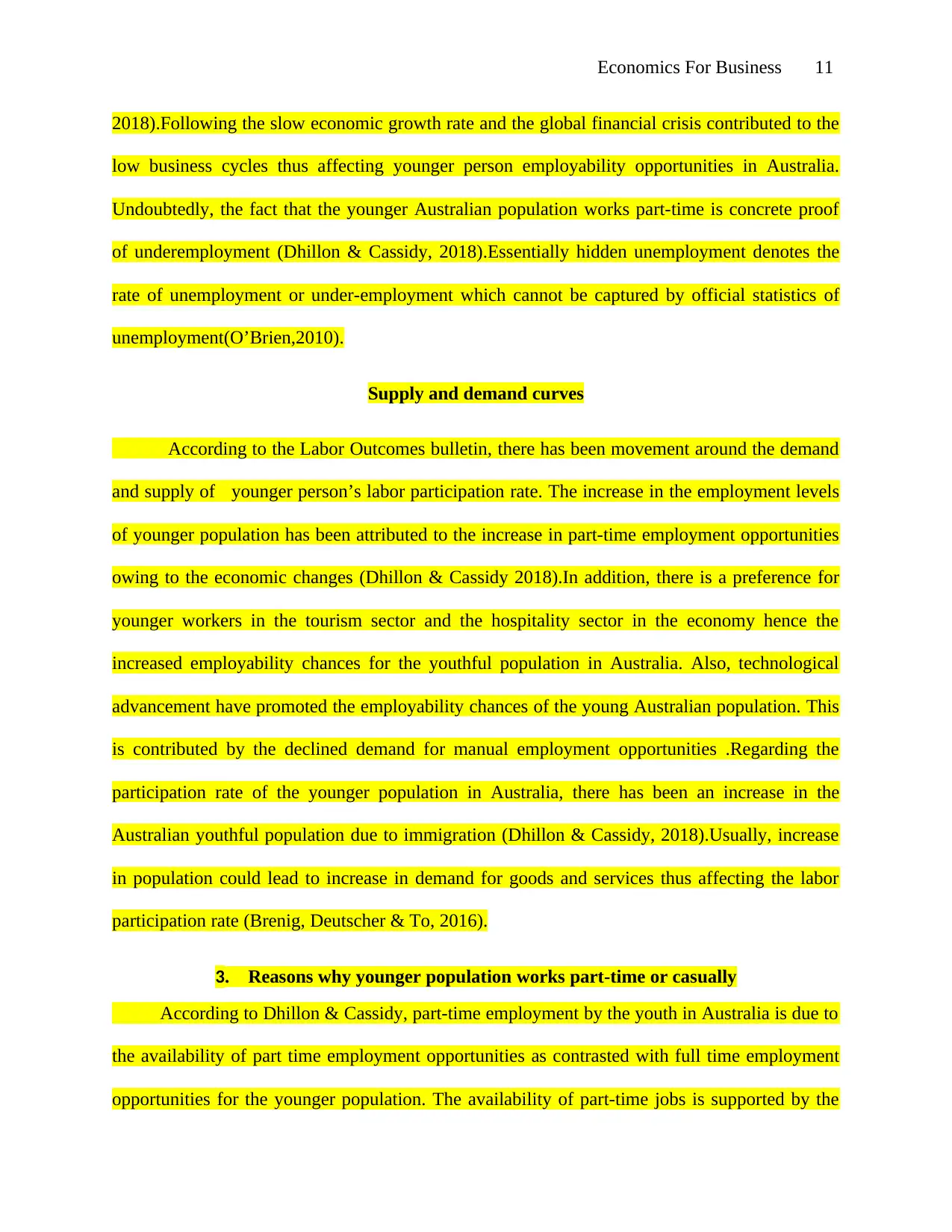
Economics For Business 11
2018).Following the slow economic growth rate and the global financial crisis contributed to the
low business cycles thus affecting younger person employability opportunities in Australia.
Undoubtedly, the fact that the younger Australian population works part-time is concrete proof
of underemployment (Dhillon & Cassidy, 2018).Essentially hidden unemployment denotes the
rate of unemployment or under-employment which cannot be captured by official statistics of
unemployment(O’Brien,2010).
Supply and demand curves
According to the Labor Outcomes bulletin, there has been movement around the demand
and supply of younger person’s labor participation rate. The increase in the employment levels
of younger population has been attributed to the increase in part-time employment opportunities
owing to the economic changes (Dhillon & Cassidy 2018).In addition, there is a preference for
younger workers in the tourism sector and the hospitality sector in the economy hence the
increased employability chances for the youthful population in Australia. Also, technological
advancement have promoted the employability chances of the young Australian population. This
is contributed by the declined demand for manual employment opportunities .Regarding the
participation rate of the younger population in Australia, there has been an increase in the
Australian youthful population due to immigration (Dhillon & Cassidy, 2018).Usually, increase
in population could lead to increase in demand for goods and services thus affecting the labor
participation rate (Brenig, Deutscher & To, 2016).
3. Reasons why younger population works part-time or casually
According to Dhillon & Cassidy, part-time employment by the youth in Australia is due to
the availability of part time employment opportunities as contrasted with full time employment
opportunities for the younger population. The availability of part-time jobs is supported by the
2018).Following the slow economic growth rate and the global financial crisis contributed to the
low business cycles thus affecting younger person employability opportunities in Australia.
Undoubtedly, the fact that the younger Australian population works part-time is concrete proof
of underemployment (Dhillon & Cassidy, 2018).Essentially hidden unemployment denotes the
rate of unemployment or under-employment which cannot be captured by official statistics of
unemployment(O’Brien,2010).
Supply and demand curves
According to the Labor Outcomes bulletin, there has been movement around the demand
and supply of younger person’s labor participation rate. The increase in the employment levels
of younger population has been attributed to the increase in part-time employment opportunities
owing to the economic changes (Dhillon & Cassidy 2018).In addition, there is a preference for
younger workers in the tourism sector and the hospitality sector in the economy hence the
increased employability chances for the youthful population in Australia. Also, technological
advancement have promoted the employability chances of the young Australian population. This
is contributed by the declined demand for manual employment opportunities .Regarding the
participation rate of the younger population in Australia, there has been an increase in the
Australian youthful population due to immigration (Dhillon & Cassidy, 2018).Usually, increase
in population could lead to increase in demand for goods and services thus affecting the labor
participation rate (Brenig, Deutscher & To, 2016).
3. Reasons why younger population works part-time or casually
According to Dhillon & Cassidy, part-time employment by the youth in Australia is due to
the availability of part time employment opportunities as contrasted with full time employment
opportunities for the younger population. The availability of part-time jobs is supported by the
⊘ This is a preview!⊘
Do you want full access?
Subscribe today to unlock all pages.

Trusted by 1+ million students worldwide
1 out of 16
Related Documents
Your All-in-One AI-Powered Toolkit for Academic Success.
+13062052269
info@desklib.com
Available 24*7 on WhatsApp / Email
![[object Object]](/_next/static/media/star-bottom.7253800d.svg)
Unlock your academic potential
Copyright © 2020–2025 A2Z Services. All Rights Reserved. Developed and managed by ZUCOL.





